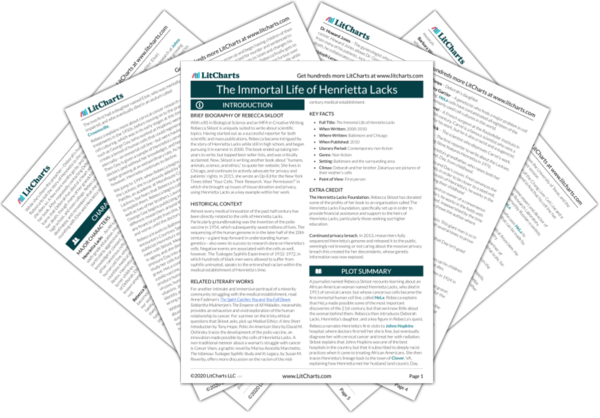The history of the HeLa cell line is not simply a story of a single woman, a single family, or even a single field (cellular biology). It is, instead, the narrative of a world moving towards a modern, scientific age. To modern readers, the treatments enacted on Henrietta and the experiments carried out on many unknowing subjects are simply horrific. As the book moves forward, and as more and more innovations continue to come about through the HeLa cell line, we begin to understand just how far technology has come since the narrative began. The same medical establishment that didn’t even understand the dangers of radiation is, by the end of the book, producing blown-up, colored slides of single chromosomes. Henrietta is crucial to this narrative because it was only due to her cells that many of these innovations came about.
We also see, as HeLa becomes more and more common in the scientific world, how the forces of globalization begin to shape the narrative. Henrietta’s cells, for instance, eventually show up in Russia, and even go up into space. As her genetic material spreads from a single hospital to far-flung countries, we as readers are able to track how interconnected the world has become, and how crucial technology has become to every aspect of our lives. While the book often forces us to see the shades of gray within the medical establishment—a place that encourages privilege and often views patients as material rather than people—we still have to stop and wonder at the magnificent inventions that medicine has given us, and at the sheer scope of Henrietta’s reach. Her story is the story of modern science, one that has ups and downs, but has undoubtedly created some of the greatest miracles of the past half-century.
Technology and Globalization ThemeTracker

Technology and Globalization Quotes in The Immortal Life of Henrietta Lacks
The Lackses challenged everything I thought I knew about faith, science, journalism, and race. Ultimately, this book is the result. It’s not only the story of HeLa cells and Henrietta Lacks, but of Henrietta’s family—particularly Deborah—and their lifelong struggle to make peace with the existence of those cells, and the science that made them possible.

Unlock explanations and citation info for this and every other The Immortal Life of Henrietta Lacks quote.
Plus so much more...
Get LitCharts A+For Henrietta, walking into Hopkins was like entering a foreign country where she didn’t speak the language…she’d never heard the words cervix or biopsy. She didn’t read or write much, and she hadn’t studied science in school. She, like most black patients, only went to Hopkins when she thought she had no choice.
Henrietta’s cells weren’t merely surviving, they were growing with mythological intensity...They kept growing like nothing anyone had ever seen, doubling the numbers every twenty-four hours, stacking hundreds on top of hundreds, accumulating by the millions.
Mary’s gaze fell on Henrietta’s feet, and she gasped: Henrietta’s toenails were covered in chipped bright red polish. “When I saw those toenails,” Mary told me later, “I nearly fainted. I thought, Oh jeez, she’s a real person. I started imagining her sitting in her bathroom painting those toenails, and it hit me for the first time that those cells we’d been working with all this time and sending all over the world, they came from a live woman. I’d never thought of it that way.”
Black scientists and technicians, many of them women, used cells from a black woman to help save the lives of millions of Americans, most of them white. And they did so on the same campus—and at the very same time—that state officials were conducting the infamous Tuskegee syphilis studies…
Every human being has an inalienable right to determine what shall be done with his own body. These patients then had a right to know…the contents of the syringe: and if this knowledge was to cause fear and anxiety or make them frightened, they had a right to be fearful and frightened and thus say NO to the experiment.
John Hopkin didn’t give us no information about anything. That was the bad part. Not the sad part, but the bad part, cause I don’t know if they didn’t give us information because they was making money out of it or if they was just wanting to keep us in the dark about it. I think they made money out of it, cause they were selling her cells all over the world and shipping them for dollars.
Only people that can get any good from my mother cells is the people that got money, and whoever sellin them cells—they get rich off our mother and we got nothing…All those damn people didn’t deserve her help as far as I’m concerned.
Truth be told, I can’t get mad at science, because it help people live, and I’d be a mess without it. I’m a walking drugstore! I can’t say nothing bad about science, but I won’t lie, I would like some health insurance so I don’t got to pay all that money every month for drugs my mother cells probably helped make.
Deborah and Zakariyya stared at the screen like they’d gone into a trance, mouths open, cheeks sagging. It was the closest they’d come to seeing their mother alive since they were babies.
[Deborah] raised the vial and touched it to her lips. “You’re famous,” she whispered, “Just nobody knows it.”











